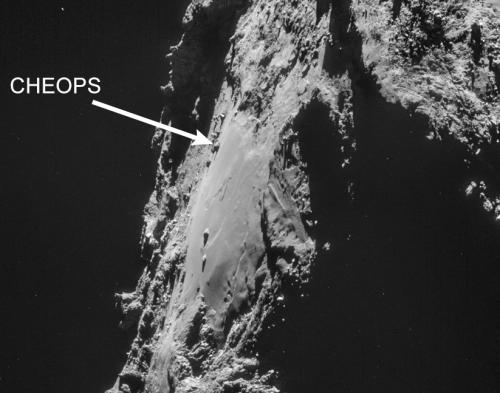At http://phys.org/print341155255.html … the journal Science, January 23rd, has published four articles on the Rosetta Mission – so get down to WH Smith's. Mind you, they are still saying the comet is composed of ice, dust, and space debris, a left over of the early days of the solar system. The lens they are looking through may not have changed too much but they are dealing with lots of new information. Describing the visual outline of the comet they say it is roughly the shape of a rubber duck, two lobes connected by a thin neck. Most of the outgassing is occuring at the neck. They are actively looking for deposits of ice and water, it would seem, a search that will continue in earnest as the comet gets closer to the Sun.
We are then informed comets are 'twice as black as coal' with a thick layer of dust accross the surface. This effectively agrees with folklore and religious imagery of a black deity (that also manifested themselves in a white form). Kali springs to mind. We also have the black figures confronting the hero in the wild wood of Romance, often hopping about on one leg, having a single burning eye, one arm etc. Druids were said to adopt such a pose when getting the massed ranks of warriors wound up before launching an attack on an enemy. The search is also on for sublimating gases as this will be where there are cracks in the dust layer which will lead them to water and ice – it is thought.
Comets have little gravity and dust and gas is able to flow freely into space. However, one surprise is that a cloud of particles orbits the comet.
Another paper in the same issue of Science, by Murthy Gudipati, has been looking at carbon based molecules on the surface. They expected to find evidence of alcohols, carboxlic acids and nitrogen containing amines. What they found were much simpler hydrocarbons.
At http://phys.org/print341154689.html … there is more of the same … and at http://phys.org/print341154987.html … we have a model of the composition of known elements
 and this image is from the underside of the comet. It seems the composition of the coma also changes over time. It is in fact the atmosphere of the comet, stretched by the solar wind.
and this image is from the underside of the comet. It seems the composition of the coma also changes over time. It is in fact the atmosphere of the comet, stretched by the solar wind.
At http://phys.org/print341139185.html … we have several images of the far side of the comet. One images shows a cluster of boulders on a flat surface (above). It is not yet known what the boulders are made of – and why they persist. They have all the appearance of rocks – but we shall have to wait and see.
